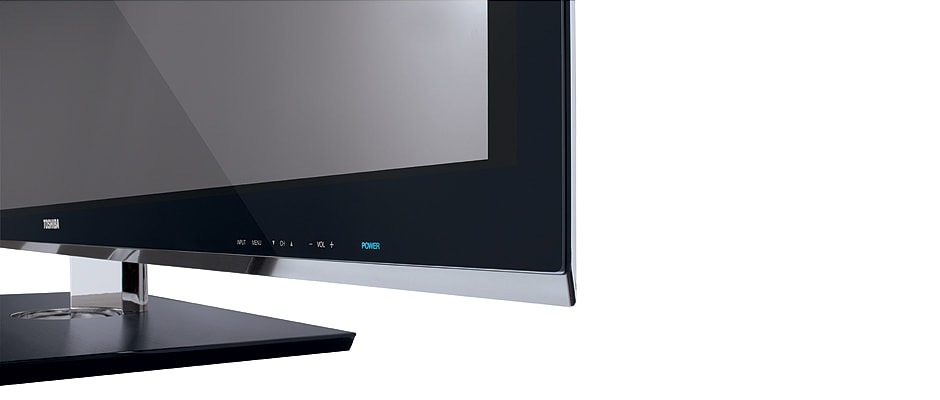Pros
Cons
Introduction
Overall Design
{{section_header}}{{section.name}}{{/section_header}}
Meet the {{product.name}}. Gaze upon the visage of the {{product.model}}, virtually indistinguishable from many of the other mid-range television sets. With a very flat and featureless bezel, the {{product.name}} will blend well with most environments, but is somewhat unremarkable.
Front
{{section_header}}{{section.name}}{{/section_header}}

Back
{{section_header}}{{section.name}}{{/section_header}}

Sides
{{section_header}}{{section.name}}{{/section_header}}

Stand/Mount
{{section_header}}{{section.name}}{{/section_header}}
Though the big hole in the stand may look a little out of the ordinary, it doesn't seem to serve anything but an aesthetic purpose here. What is important, however, is that this stand allows your TV set to swivel, allowing it to be angled towards your favorite viewing spot should it fall outside of the ideal viewing angle.

Remote Control
{{section_header}}{{section.name}}{{/section_header}}
The remote to the {{product.name}} is a rather large piece of equipment, with slightly disappointing key travel and weight balance. That being said, it fits in the hand quite nicely, and most of the common functions are easily accessible to the thumb of the gripping hand.

In the Box
{{section_header}}{{section.name}}{{/section_header}}
Packaged with your shiny new {{product.name}} is a manual, a couple analog adapters, a hex key, and assorted documentation. Absent are active 3D glasses, if you want to use this set for 3D movie viewing.
Black Level
{{section_header}}{{section.name}}{{/section_header}}
Though we typically only deem a deepest black level of 0.1cd/m2 or less as "good," the {{product.name}}'s deepest black was recorded at 0.11cd/m2, which is enough to coax a reluctant "not bad" out of our reviewers. While it's certainly not a great score, the entry to mid-level consumer will certainly not notice much to complain about when it comes to contrast, which black levels are very important to. More on how we test black level.
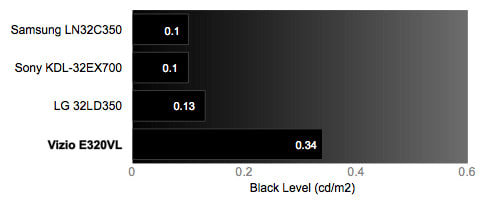
Peak Brightness
{{section_header}}{{section.name}}{{/section_header}}
With a peak brightness of 260.3 cd/m2, the {{product.name}} should provide you comfortable viewing in almost any environment aside from direct sunlight. You really only need a peak brightness of 200 cd/m2 for viewing in a well-lit room, and anything beyond that is just gravy. More on how we test peak brightness.
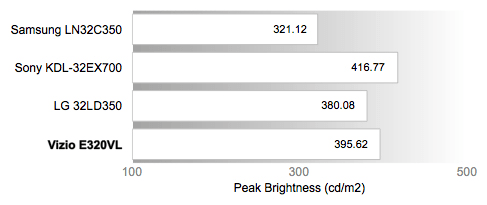
Contrast
{{section_header}}{{section.name}}{{/section_header}}
Due to its okay marks in deepest black level and its good peak brightness, the {{product.name}} has a respectable contrast ratio of 2366:1, which is very good for an LCD TV under $1000. As you can see from the chart below, only the Samsung plasma screen was able to outmatch the {{product.name}}. More on how we test contrast.

Tunnel Contrast
{{section_header}}{{section.name}}{{/section_header}}
The {{product.name}} struggled a little bit in maintaining a similar black level when the area of white on the screen varies, but overall it did an average job here. You may notice some areas of black lightening a bit when there is a bunch of white area surrounding them. More on how we test tunnel contrast.
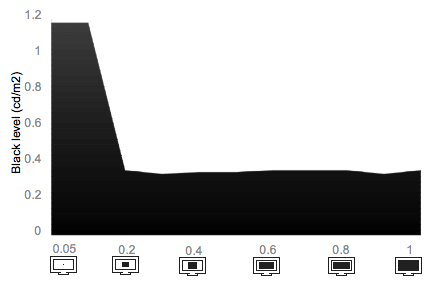
White Falloff
{{section_header}}{{section.name}}{{/section_header}}
Where the {{product.name}} had difficulties in tunnel contrast, it did not have the same shortcomings in white falloff. No matter how small a sliver of white area on your screen is, it will remain almost identically bright, no matter how much or how little area it takes up. More on how we test white falloff.
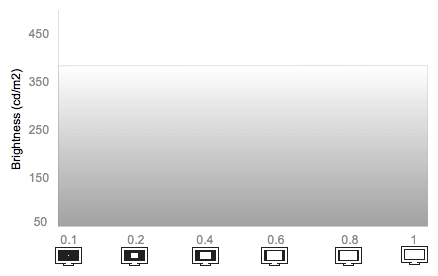
Uniformity
Greyscale Gamma
{{section_header}}{{section.name}}{{/section_header}}
When we test greyscale gamma, we look at two aspects of our charts before scoring a TV’s performance: the smoothness and slope of the line. The smoothness of the line tells us whether or not there were certain values of signal intensity that the TV simply couldn’t produce, or if they were produced incorrectly. Ideally, the slope of the line should lie somewhere between 2.1 and 2.2, but depending on a TV’s performance, this may vary. If it does, that means it doesn’t quite produce the ideal values along the greyscale, which can result in lost detail, especially in shadows.
Despite its overall good score, the {{product.name}} has a few issues with each area listed above that we feel are worth discussing. First, the line itself isn't very straight, making certain greyscale values display incorrectly at about the ranges where you see the bumps and curves in the response line. In regards to the slope of the line, the {{product.name}} clocks in at 2.38. Considering that we see many TV sets with gamma slopes of 2.5 or higher, this isn't all that bad. Still, it's outside of our ideal limits, so be advised that you may see your picture getting a little brighter faster than it would if the response were within the ideal limits. More on how we test greyscale gamma.
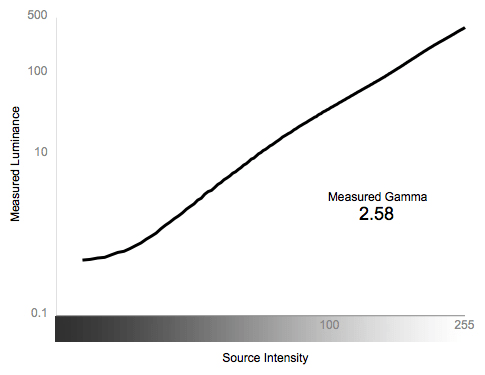
Color Temperature
{{section_header}}{{section.name}}{{/section_header}}
While the {{product.name}} does manage to keep its color error below the limits of human perceptibility for most of the greyscale, but it does have a slight warming problem the closer you get to the darkest end of signal intensity. Thankfully this level of color error isn't overbearing, but if you know what to look for, it's definitely there. More on how we test color temperature.

RGB Curves
{{section_header}}{{section.name}}{{/section_header}}
We'll admit that this is a result that perplexed us a little bit. These curves are about the best you can get without clipping the brightest color values. Take a look at the curves below: notice how the green curve is more or less even in its increase in signal intensity, and the other curves aren't? Wherever you see a jump or plateau in the curves is a color value that the {{product.name}} simply cannot display accurately.
In addition to this problem, the {{product.name}} is very difficult to calibrate without tradeoffs in this area. Specifically, the brightness seems to increase much more than in other models of television on the market, and if you decrease it to eliminate the peaking at the end of the spectrum, the curves never reach the brightest values, and trail off far lower than they should (specifically the blues). Though the curves do peak a bit with our calibration, we feel that the tradeoff in color performance is not worth lowering the brightness. More on how we test RGB curves.

Below are all the linear response strips for each color of each TV discussed in the review. Take note of any color banding, as it is indicative of errors on the part of the respective TV at those color values.
Motion Performance
{{section_header}}{{section.name}}{{/section_header}}
While the {{product.name}} certainly handles motion well enough, it does occasionally surprise you with small errors that come out of the woodwork here and there. Without any motion processing or interpolation enabled, you may notice that small, compact, high-frequency patterns might strobe for a small period of time, then correct themselves. Beyond this, we did not see the normal errors that plague lower-end televisions like stair-stepping, ghosting, or false coloration. The television does seem to have a small refresh rate issue in which moving boxes will appear more like parallelograms than squares. More on how we test motion performance.
3:2 Pulldown & 24fps
{{section_header}}{{section.name}}{{/section_header}}
In order to display 24fps content more smoothly, most modern televisions will convert film content using what's called a 3:2 pulldown to display the content as best as possible at the television's native rate of 60Hz. We found that the {{product.name}} handles this task fairly well, displaying few errors. More on how we test 3:2 pulldown and 24fps.
Resolution Scaling
{{section_header}}{{section.name}}{{/section_header}}
When you hook up your external media sources, you should know that they are not all exported in the same resolution, meaning the television has to convert each output signal to best match the screen size. Here is what we discovered while changing resolutions on the {{product.name}}. More on how we test resolution scaling.
480p
Overscan and Moiré interference were horrible on the {{product.name}}, with the image clipping at 5% vertically, and 3% horizontally. High frequency patterns pare plagued with resolution issues and artifacts.
720p
The {{product.name}} handled this resolution well, only displaying minor false coloration in high frequency patterns that are hardly noticeable.
1080i
The {{product.name}} has a little trouble with high-frequency patterns, showing some interference and resolution issues. Otherwise the picture was not too bad.
1080p
Great marks here, like the 720p resolution. Very little in the way of issues to complain about.
Formats
{{section_header}}{{section.name}}{{/section_header}}
The {{product.name}} has a standard resolution of 1080p and can display all standard NTSC resolutions.
Viewing Angle
{{section_header}}{{section.name}}{{/section_header}}
Because the {{product.name}} relies on older screen technology called TFT display, we did not have high hopes for the viewing angle test. Though we did not record an unexpected result, the viewing angle of the {{product.name}} is pretty bad for any TV. If you sit at an angle of greater than 16 degrees away from center, you can expect to see a contrast dropoff of 50%. As you can see below, different screen technologies (Plasma, IPS LCD) will offer you different viewing angles, but much are universally better than the TFT LCD displays.

Reflectance
{{section_header}}{{section.name}}{{/section_header}}
Though it's not the worst we've ever seen, the {{product.name}} has a fairly reflective screen. That's not to say that Toshiba gave it a mirror-like surface, but the reflection pattern and reflection angle are quite large and annoying. Despite its efforts to diffuse the reflected light, the sunburst pattern just seems to make more of the screen area invisible behind a rainbow-colored glare.
Video Processing
{{section_header}}{{section.name}}{{/section_header}}
The {{product.name}} comes pre-loaded with a bunch of video processing modes, some more effective than others. Below is a tablet with our impressions of each.
Calibration
{{section_header}}{{section.name}}{{/section_header}}
Before subjecting our review models to our battery of tests, we calibrate the picture settings using DisplayMate software to make sure we measure what the television is capable of, not what it was handicapped to by the original settings. The {{product.name}} in particular is easy to calibrate. Using Movie 1 as a starting mode, we adjusted the TV's calibration as follows:

All of our calibration is done in conjunction with the DisplayMate software.
](http://www.displaymate.com/)
Video Modes
{{section_header}}{{section.name}}{{/section_header}}
The {{product.name}} has a handful of video modes for different viewing situations in mind. Below is a description of their intended use.
Connectivity
{{section_header}}{{section.name}}{{/section_header}}
Because of the layout of the ports on the {{product.name}}, you will find several of the commonly-used ports like an HDMI port, a composite video input, the ethernet port, VGA in, 3.5mm in, and the USB ports for external media.

The downward-facing port panel is home to some of the more advanced options of the {{product.name}}, which include some of the cooler options we've seen in a while. For example, the IR blaster cable port allow you to hook up the IR blaster cable. What is a blaster cable, you ask? Well, once you hook it up to the TV, you affix the ends of the cable over the IR sensors of your external media devices, and then you program the remote to control them without sending any signal to said devices; all commands go through the TV itself, which then either takes the signal from the devices or command it.
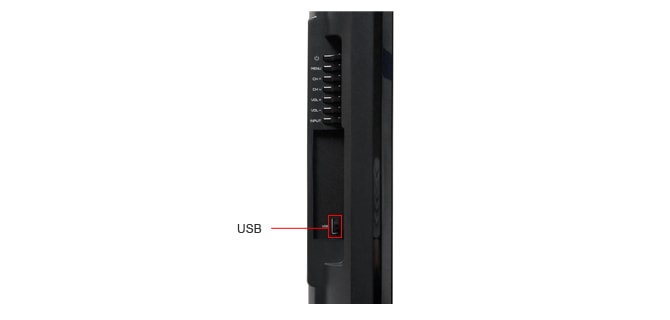
Another unique thing about the {{product.name}} is just how many different types of ports it has. The recent trend in the TV world has been to consolidate as much as possible into the HDMI ports and few analog options to placate those with older external media sources. If you have a wide array of specialized media sources, this may be a great TV for you to pick up, but the limited number of component/composite ports will limit how many connections you can make of the same type. If you have a bunch of old consoles or VHS players, see if you can find a splitter.
{{product.manufacturer_specs['Connectivity Tour Image 3']}}
Placement
{{section_header}}{{section.name}}{{/section_header}}
The placement of the ports on the back of the {{product.name}} makes it painfully obvious that they designed the set to facilitate users mounting the set to their walls, as most of the ports can be accessed even if the {{product.model}} is flush against the wall. The only knock on this type of design is that because the TV set itself is so thin, very few people will be able to reach the ports without having a mount that increases the gap between the TV and the wall.
Audio Quality
{{section_header}}{{section.name}}{{/section_header}}
Without any fiddling, the audio quality of the {{product.name}} is certainly better than we've seen in most of the entry-level televisions, but this set is not entry-level. As such, it's a little disappointing to hear the crummy audio quality that the {{product.model}} offers with it's multiple options. Though the set offers such things as bass boost and "voice enhancer," all these features seem to do is work within the limitations of the set's speakers and de-emphisise the ranges of sound frequency that aren't among the "enhanced" ranges. It doesn't actually enhance anything. If you have an external audio setup, we recommend using that instead.
Menu Interface
{{section_header}}{{section.name}}{{/section_header}}
Overall, the menus of the {{product.name}} aren't horrifying to look at, but they are quite unattractive. That being said, the menus are easy to locate and navigate, with very few surprises or hidden items that can't be accessed unless there is an exact condition met (yes, we have seen this in the past). Overall, a decent, if ugly, interface.

Advanced menus nest under their respective parent menus, and are relatively easy to find. There are many advanced options for those of you who like to fiddle with the picture in ways not available on other televisions, but we'd recommend not messing around with this too much.

Instruction Manual
{{section_header}}{{section.name}}{{/section_header}}
As far as menus go, this one is not only very basic, but it is also very informative. The verbiage is not confusing, the pictures are helpful, and the wealth of information in the manual is very exhaustive. It's not easy to navigate, or easy to look at without falling asleep, but if you do have an issue with the TV itself, you will find the answer in the manual... if you can keep with it.

A manual for so many TV models, they have to be further categorized by type.
Internet Features
{{section_header}}{{section.name}}{{/section_header}}
Astute observers will note that the {{product.name}} has an ethernet port on the back of their TV set. Though the {{product.name}} doesn't really offer the same range of online content as say, a high-end LG, you still can explore a large range of apps provided by a partnership between Toshiba and Yahoo for basic content like weather. For other applications, there are a few pre-loaded streaming applications that seem to do okay, but take forever to load.
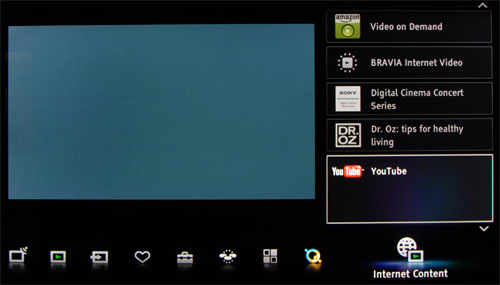
Local Media Playback
{{section_header}}{{section.name}}{{/section_header}}
With the USB port on the side panel, you can upload and browse through your media through a somewhat simple interface. You can set up a slide show of .jpegs, watch a limited range of video file formats, and listen to music. Though the interface is somewhat spartan in terms of options, and certainly not very attractive, it should get you to where you need to go if you're simply trying to add ambiance to a party or gathering.

Other Media
{{section_header}}{{section.name}}{{/section_header}}
The {{product.name}} is "3D ready," which basically means that it can handle 3D content, but it does not come packaged with the active-shutter glasses necessary to view 3D content. If you wish to do this, you'll have to plunk down a considerable amount of cash for the capability.
Power Consumption
{{section_header}}{{section.name}}{{/section_header}}
With the backlight set to an optimum level, the {{product.name}} draws an average of 116.4 watts. What does this mean for you? Well, assuming normal periods of watching every day in a year, your power bill for the TV alone should run you about $22.73
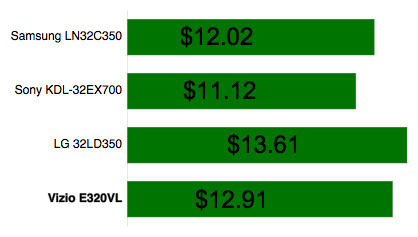
Value Comparison
{{section_header}}{{section.name}}{{/section_header}}
Though the {{product.name}} is a bit pricy with an MSRP of $2,599, you can probably find it for less online at this point in its life cycle. For the price, you get a few more connectivity options than you do with the Vizio, but you pay for those extra features, boy howdy you pay.
Blacks & Whites
{{section_header}}{{section.name}}{{/section_header}}
Though the Vizio has a very bright screen, the {{product.name}}'s far better deepest black and its decent brightness give it a far wider contrast ratio than that of the Vizio. Neither TV has any issues with screen brightness, so the {{product.name}} takes this one.

Color Accuracy
{{section_header}}{{section.name}}{{/section_header}}
The Vizio has better marks across the board, with a more accurate color gamut, far less color temperature error, and much smoother RGB curves.
Motion
{{section_header}}{{section.name}}{{/section_header}}
While the Vizio does have a 1.5 point lead on the {{product.model}}, don't read into the difference too much; though the Vizio does handle motion better than the {{product.name}}, the two are actually closer in performance than the score may seem. Both perform about par for the course at their price point.
Viewing Effects
{{section_header}}{{section.name}}{{/section_header}}
Though neither impress with their tiny viewing angles, the {{product.name}} very narrowly has a wider viewing angle than the Vizio.
Connectivity
{{section_header}}{{section.name}}{{/section_header}}
When it comes to connectivity, we typically remind users that this comparison is heavily dependent on your needs. While both televisions have a respectable amount of input and output ports, the {{product.name}} has more analog input options, allowing the retro gamer a little more freedom.
Other Comparisons
{{section_header}}{{section.name}}{{/section_header}}
While both television sets can display 3D content, only the Vizio comes with glasses, or any means of actually employing the technology, whereas the {{product.name}} is merely "3D ready" (code for: go out and buy more stuff to make this work!)
Value Comparison
{{section_header}}{{section.name}}{{/section_header}}
Both televisions are roughly the same in MSRP, the LG only costs about $100 more than the {{product.name}}. What do you get for that extra $100? Well, it should be noted that the LG does outperform the {{product.name}} in some areas, but its performance isn't different enough to really set it apart from the {{product.name}}.
Blacks & Whites
{{section_header}}{{section.name}}{{/section_header}}
With a much lower deepest black and an acceptably-high peak brightness, the {{product.name}} nets a much wider contrast ratio than does the LG contender. If you're looking for good contrast performance, the {{product.name}} is the better bet.

Color Accuracy
{{section_header}}{{section.name}}{{/section_header}}
Though it's not saying much, the LG has much better color performance scores across the board here, as it has less color temperature error, a more accurate color gamut, and far better RGB response curves.
Motion
{{section_header}}{{section.name}}{{/section_header}}
The {{product.name}} has much better motion performance, maintaining more detail and smoothness of motion than does the LG.
Viewing Effects
{{section_header}}{{section.name}}{{/section_header}}
It's not saying much at all, but the viewing angle of the LG TV is a few degrees wider on either side than the {{product.name}}'s viewing angle. Still, even for LCD TVs, they're not that great in this area.
Connectivity
{{section_header}}{{section.name}}{{/section_header}}
While it's a little silly to compare how many ports a TV has once it reaches a certain point, we would be hiding the truth if we didn't inform you that the LG has more connectivity options on the back of its set, as well as the ability to connect to wireless networks (something the Toshiba lacks out of the box).
Other Comparisons
{{section_header}}{{section.name}}{{/section_header}}
While both TVs are capable of displaying 3D content, only the LG actually comes with the equipment necessary to do so; if you want to use the {{product.name}} as a 3DTV, you will have to go out and buy Toshiba's expensive active-shutter 3D glasses.
Value Comparison
{{section_header}}{{section.name}}{{/section_header}}
Though the {{product.name}}'s MSRP is about $800 higher than that of the Samsung UN46D6500, you get quite a bit more bang for your buck performancewise with the lower-priced Samsung. That being said, if you want the nifty IR features or wide range of analog connectivity options, the price may be worth it to you to pick up the {{product.name}}.
Blacks & Whites
{{section_header}}{{section.name}}{{/section_header}}
Though both the {{product.name}} and the Samsung have similarly bright screens, the Samsung has a far lower deepest black, giving it not only a better score, but a wider contrast ratio.

Color Accuracy
{{section_header}}{{section.name}}{{/section_header}}
Though the Samsung does have a somewhat odd problem with color temperature error that places it behind the {{product.name}}, the {{product.model}} falls short in color gamut and RGB curve response.
Motion
{{section_header}}{{section.name}}{{/section_header}}
Much like the score indicates, the Samsung absolutely blows the {{product.name}} away in terms of motion performance. Though the {{product.name}} isn't too bad in handling motion, all of the small errors it will show you are virtually nonexistent on the UN46D6500.
Viewing Effects
{{section_header}}{{section.name}}{{/section_header}}
Even though the viewing angle on the {{product.name}} is pretty bad, that of the Samsung is far worse. Were you to watch it at an angle, the contrast will drop off by over 50% less than 20 degrees from center. This is not a good TV for viewing in large groups.
Connectivity
{{section_header}}{{section.name}}{{/section_header}}
Simply put, the {{product.name}} has more connectivity options than does the Samsung, but both have a respectable amount and should satisfy most viewers. Still, if you'd like the most analog ports you can get, we'd stick with the {{product.name}}. All that being said, the Samsung has one of the best online content platforms on the market today, and if you love browsing the web for apps and streaming content, the Samsung is the hands-down winner here.
Other Comparisons
{{section_header}}{{section.name}}{{/section_header}}
Though both TV sets are capable of displaying 3D content, the {{product.name}} does not come with the equipment necessary to actually view content in 3D without a separate, expensive purchase of Toshiba's active-shutter 3D glasses.
Conclusion
The {{product.name}} ($2,599 MSRP) is a fairly average high-end set that does fairly well in some areas, disappoints in others, and offers some very unique features that are of debatable worth. We'd recommend shopping around first if you decide that this TV set is for you.
Despite its bizarre shortcomings in color performance, the {{product.name}} has a good black and white performance with a wide contrast ratio, and it handles motion fairly well for an LCD TV. It may not perform at the level that its MSRP would suggest, but this isn't a terrible TV, just a terribly priced one.
Toshiba does go out of its way to make sure that just about every possible port is included on the TV set, as well as a few bells and whistles like the extra IR options, but for a TV that's "3D ready" we're a little surprised that Toshiba squandered the opportunity to support this feature a little more: the TV set itself is perfectly capable of outputting a 3D signal right out the box, and the only hindrance to users watching this is a lack of 3D glasses.
Overall this isn't a bad pickup if you can find it for less than the MSRP online, and its motion performance, connectivity options, and black and white performance will not disappoint if you find a bargain on this set. Though it's a little overpriced for its performance, that isn't to say that it shouldn't be bought, just that it should probably be priced closer to other TV sets that fall in the mid-range.
Model Series Comparison
{{section_header}}{{section.name}}{{/section_header}}
The xxWX800U series has two models, the {{product.model}} and the 55WX800U. Both are televisions with LED-backlit TFT LCD screens with similar connectivity options and interfaces.
Photo Gallery
{{photo_gallery "Front Tour Image", "Back Tour Image", "Sides Tour Image", "Stand Photo", "Controls Photo", "Remote Control Photo", "Connectivity Tour Image 1", "Connectivity Tour Image 2", "Connectivity Extra Photo", "Menu Main Photo", "Menu 2 Photo", "Internet Features 1 Photo", "Internet Features 2 Photo", "Internet Features 3 Photo", "Local Media Playback 1 Photo", "Local Media Playback 2 Photo"}}
Ratings & Specs
{{manufacturer_specs_table}}
Meet the tester
A seasoned writer and professional photographer, Chris reviews cameras, headphones, smartphones, laptops, and lenses. Educated in Political Science and Linguistics, Chris can often be found building a robot army, snowboarding, or getting ink.
Checking our work.
Our team is here to help you buy the best stuff and love what you own. Our writers, editors, and experts obsess over the products we cover to make sure you're confident and satisfied. Have a different opinion about something we recommend? Email us and we'll compare notes.
Shoot us an email